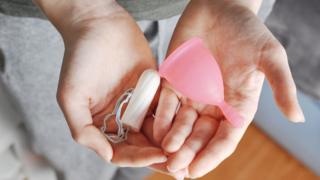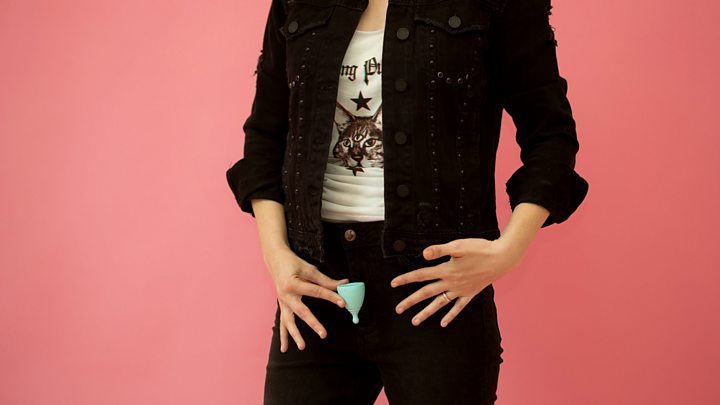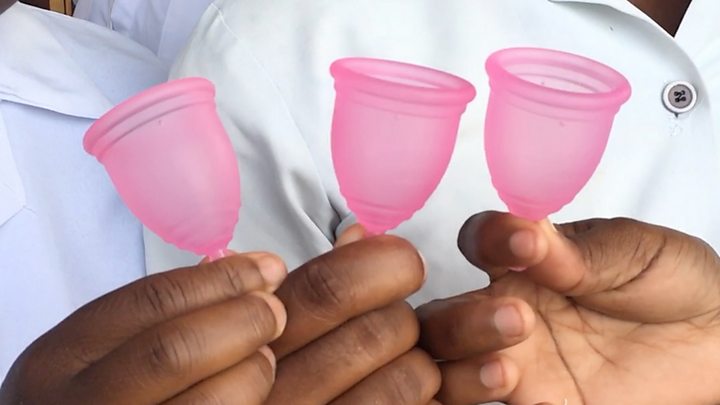Menstrual cups ‘as reliable as tampons’
 Image copyright Getty Images
Image copyright Getty Images Women can be assured that menstrual cups are as leakproof as tampons and pads, say researchers who have carried out the first, large scientific review of sanitary products.
Menstrual cups collect rather than absorb period blood.
They fit into the vagina but, unlike tampons, are reusable.
Although they have been gaining in popularity, the review found awareness of menstrual cups among women was relatively low.
The work, published in the Lancet Public Health journal, looked at 43 studies involving 3,300 women and girls living in rich and poor countries.
Common concerns about trying a menstrual cup included pain and difficulty fitting or removing it, as well as leakage and chafing.
But the review found complications were rare.
Results from 13 of the studies found about 70% of women wanted to continue using menstrual cups once they were familiar with how they worked.
Four studies, involving nearly 300 women compared leakage between menstrual cups and disposable pads or tampons. Leakage was similar in three of the studies and significantly less among menstrual cups in one study.
How do they work?
Menstrual cups are made of soft, flexible material, such as rubber or silicone.
Once inserted into the vagina they create a suction seal to stop any seepage of blood.
They can collect more menstrual blood than tampons or sanitary pads, but need to be emptied and washed regularly.
There are two main types – a vaginal cup which is generally bell-shaped and sits lower in the vagina, and a cervical cup which is placed higher up, much like a diaphragm for contraception.
How to use one
Find the right size cup to fit your body. The size does not relate to your menstrual flow.
Make sure the cup is clean and dry before use.

Media playback is unsupported on your device
Fold the cup and place it into the vagina where it can then unfold and form a leak-free seal.
To remove, squeeze the bottom of the cup to release the seal.
Empty the contents into the toilet and rinse or wipe the cup clean.
Sterilise the cup between periods.
Not a fan?
Lots of different brands are available to try, but a menstrual cup may not be for everyone. It can take several attempts to feel confident about using one.
Debra Holloway, gynaecology nurse consultant and member of the Royal College of Nursing said: “There’s a whole range of products out there and it’s worth persevering and finding the right thing that suits you.”
What women use should be a personal choice, say experts. But better advice and evidence is needed to give them the information they need to make this decision.
Lead author of the research, Prof Penelope Phillips-Howard from the Liverpool School of Tropical Medicine, said: “Despite the fact that 1.9 billion women globally are of menstruating age – spending on average 65 days a year dealing with menstrual blood flow, few good quality studies exist that compare sanitary products.”
Are they cheaper than tampons or sanitary towels?
Between the ages of 12 and 52, a woman who does not have children will have about 480 periods, according to the NHS.
A cup costs around £15 to £25, which is much more than a box of tampons, but it can be reused every month and lasts for up to 10 years, making it a cost-effective option in the long term.
- Period poverty: Free sanitary products for schools is ‘huge step’
- Tampon tax: How much have you spent?
Being reusable, rather than disposable, menstrual cups are also seen as a greener option for the environment than tampons and sanitary towels.
Reusable, washable menstrual underwear is also available.
The researchers believe that making menstrual cups available globally could help to tackle period poverty and health problems such as infections — even where water and toilet facilities are poor.
Last year, university student Claudia Neuray spoke about trying a menstrual cup as part of a BBC challenge to go greener, saying she wanted to “cut down on waste and save money”.

Media playback is unsupported on your device
“My flatmates thought it a bit gross but I found it was just as good once I got used to it,” she said.
Have you used a menstrual cup? Please share your experiences by emailing haveyoursay@bbc.co.uk
Please include a contact number if you are willing to speak to a BBC journalist. You can also contact us in the following ways:
- WhatsApp: +44 7756 165803
- Tweet: @BBC_HaveYourSay
- Text an SMS or MMS to 61124 or +44 7624 800 100
- Please read our terms of use and privacy policy

